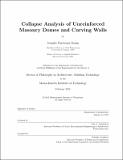Collapse analysis of unreinforced masonry domes and curving walls
Author(s)
Zessin, Jennifer Furstenau
DownloadFull printable version (81.24Mb)
Other Contributors
Massachusetts Institute of Technology. Dept. of Architecture.
Advisor
John A. Ochsendorf.
Terms of use
Metadata
Show full item recordAbstract
The safety and assessment of historic masonry structures continues to be a challenge for most analysts, especially for more complex buildings. Historic masonry structures have great cultural and economic value, but engineers have not examined the collapse modes for many masonry elements. This thesis examines the collapse of unreinforced masonry structures in response to large support displacements and constant horizontal ground accelerations. Two different structural forms are studied and collapse conditions are established for each. The aim of this research is to allow simple, but meaningful, analytical models and experimental results to inform each other in an effort to better define masonry collapse mechanisms. The first structural form to be analyzed is the masonry dome. For historical masonry domes, small outward movements of the supports will cause cracking and may lead to collapse. The critical span increase to cause collapse of a hemispherical dome is determined for domes with varying thicknesses using two small-scale physical models. In addition, the critical value of constant horizontal acceleration to cause collapse of a hemispherical dome is also examined, simulated by tilting the two domes on a plane. In both cases, a mechanism forms, rendering the dome unstable and collapse ensues. Simple analytical models, emphasizing the relationship between geometry and equilibrium, are able to accurately predict the failure limits and mechanisms. The second structural form to be analyzed is the curving masonry wall. In an effort to better understand the origins and perceived benefits of curving masonry walls, their stability is measured relative to the amount of curvature in the wall. The critical value of constant horizontal acceleration to cause collapse of a curving wall is determined using multiple equilibrium methods and compared with both full-scale and small-scale experiments for dry-stacked bricks. Based on these results, new limits for the stability of these structures are proposed.
Description
Thesis (Ph. D.)--Massachusetts Institute of Technology, Dept. of Architecture, 2012. This electronic version was submitted by the student author. The certified thesis is available in the Institute Archives and Special Collections. Cataloged from student-submitted PDF version of thesis. Includes bibliographical references (p. 176-182).
Date issued
2012Department
Massachusetts Institute of Technology. Department of ArchitecturePublisher
Massachusetts Institute of Technology
Keywords
Architecture.